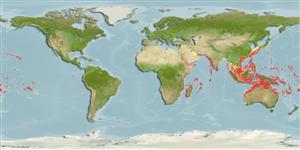Common names from other countries
Environment: milieu / climate zone / depth range / distribution range
Ecologie
marien rifbewoner; diepte 0 - 170 m (Ref. 89972). Tropical; 30°N - 32°S
Indo-Pacific: East Africa to the Hawaiian, Marquesan, and Ducie islands, north to southern Japan, south to Lord Howe and Rapa islands. Southeast Atlantic: East London, South Africa (Ref. 5372).
Grootte / Gewicht / Leeftijd
Maturity: Lm ? range ? - ? cm
Max length : 20.0 cm TL mannelijk / geslacht onbekend; (Ref. 9710); max. gerapporteerde leeftijd: 9 Jaren (Ref. 72479)
Dorsale stekels (totaal) : 10 - 14; Dorsale zachte stralen (totaal) : 20 - 25; Anale stekels: 3; Anale zachte stralen: 17 - 20.
Nocturnal species that is usually in pairs or small groups in shallow reef flats of lagoon and seaward reefs to depths of over 30 m. Juvenile occurs among rocks of inner reef flats and in tide pools (Ref. 205). Benthopelagic (Ref. 58302). Adult feeds mainly on nudibranchs, tubeworm tentacles, and other benthic invertebrates, also feeds on algae and coral polyps. Oviparous (Ref. 205). Forms pairs during breeding (Ref. 205).
Levenscyclus en paargedrag
Maturities | Voortplanting | Spawnings | Egg(s) | Fecundities | Larven
Distinct pairing (Ref. 205). Monogamous mating is observed as both obligate and social (Ref. 52884).
Heemstra, P.C., 1986. Chaetodontidae. p. 627-632. In M.M. Smith and P.C. Heemstra (eds.) Smiths' sea fishes. Springer-Verlag, Berlin. (Ref. 5372)
Status op de Rode Lijst van het IUCN (Ref. 130435)
CITES (Ref. 128078)
Not Evaluated
Gevaar voor de mens
Harmless
Gebruik door de mens
Visserij: van minder commercieel belang; Aquarium: Commercieel
Tools
Speciale rapporten
Download XML
Internetbronnen
Estimates based on models
Preferred temperature (Ref.
115969): 23.7 - 29, mean 27.7 (based on 1986 cells).
Fylogenetische diversiteitsindex (Ref.
82804): PD
50 = 0.5000 [Uniqueness, from 0.5 = low to 2.0 = high].
Bayesian length-weight: a=0.02291 (0.01133 - 0.04632), b=3.00 (2.83 - 3.17), in cm Total Length, based on LWR estimates for this Genus-body shape (Ref.
93245).
Trofisch niveau (Ref.
69278): 3.7 ±0.1 se; based on diet studies.
Weerstandsvermogen (Ref.
120179): Hoog, minimale populatieverdubbelingstijd minder dan 15 maanden (Preliminary K or Fecundity.).
Fishing Vulnerability (Ref.
59153): Low vulnerability (10 of 100).
